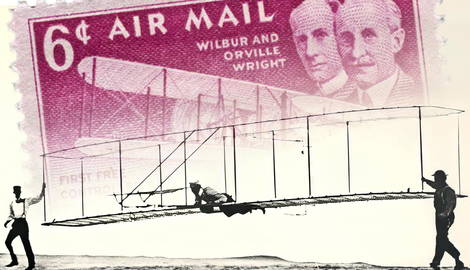
From gliders and hot air balloons to the very first airplanes, humans have long had an obsession with taking to the sky. Madcap inventors made attempts at taking flight for many centuries, until, that was, the early 20th century, when the dream finally became a reality. While the first flight in human history is generally attributed to Orville and Wilbur Wright (also known as the Wright brothers), who flew a launcher in December 1903, there are also other possible contenders who may have beaten them to it. Below we take a look at the most popular and groundbreaking engineers who broke new ground in the history of aviation.
The Wright Brothers: December 17, 1903

The first flight is most commonly associated with Orville Wright and brother Wilbur, originally from Ohio, who launched a flying machine that they had built together over North Carolina on the 17th of December 1903. The brothers slid their plane down a guiding rail and, aided by the strong winds at Kitty Hawk, lifted off the ground and soared 120 feet high for around 12 seconds. The entire moment was witnessed by a small handful of viewers, and a photograph was taken by a member of the U.S. Life-Saving Service to prove their claim was true.

While all this might seem like a done deal, there are still sceptics who doubt the Wright brothers’ claim to the title. Some critics have argued that such a small, private audience was not enough to prove the flight really happened the way it should have. Others, including the contemporary Brazilian physicist Henrique Lins de Barros, argue that their flight failed to meet certain criteria, including taking off unassisted, and flying for a predetermined length of time. He says, “If we understand what the criteria were at the end of the 19th century, the Wright Brothers simply do not fill any of the prerequisites.”
Alberto Santos-Dumont: October 23, 1906

French inventor Alberto Santos-Dumont was heir to a vast family fortune, and this gave him the time and money to pour into a series of experiments with aviation. From hot air balloons to airships, he spent much of his life obsessing over his desire to fly. Eventually, after years of experimentation, he came up with a biplane model which he flew into the air. His first documented flight took place in full view of the public in the city of Paris, when he flew a biplane 15 feet high for a distance of 200 feet.
In contrast with the Wright brothers, who relied on an assisting rail to take flight, Santos-Dumont’s plane took off completely unaided, and it is for this reason that his moment in 1906 is considered by many historians to be the first flight in history. Just 3 weeks later, Santos-Dumont broke a world record, flying an impressive 726 feet in a winged aircraft, making him a true pioneer in aircraft technology.
Gustave Whitehead: August 18, 1901

The German immigrant Gustave Whitehead, who lived his adult life in the United States, also made a significant contribution to the history of flying. Some even say he hit the sky several years before the Wright brothers, although there is not sufficient evidence to back up this claim, which some critics have dubbed “The Mythical Whitehead Flight”. The story of Whitehead’s flight first circulated in 1901, when a newspaper article in the Bridgeport Sunday Herald claimed a man had taken the first flight in history in a self-built flying machine.
According to the article, at least two witnesses saw Whitehead flying his curious, bat-like contraption which he called ‘Condor’, over the city of Bridgeport in Connecticut. There was even talk of a blurred photograph documenting the moment being exhibited during a 1906 aeronautical show in New York City, although if it did exist, it is now lost.

Whitehead even claimed he flew the plane again on January 17 1902, although there were no valid witnesses. During the 1930s, a reporter tried to track down the original eyewitnesses who had commented on Whitehead’s flight, in order to find out if the rumors were really true. However, he could only find one witness, a man named James Dickie, who admitted the story was “imaginary.” However, in 1987, a CBS News program showed flying experts testing out a replica of Whitehead’s ‘Condor’, and miraculously, they proved it actually worked, even though this still doesn’t prove whether the legendary flight actually took place or not.










